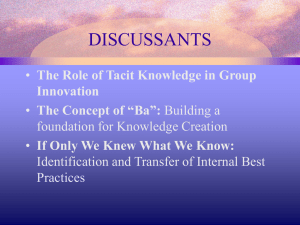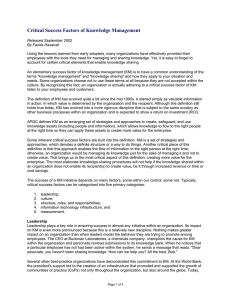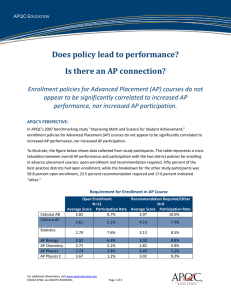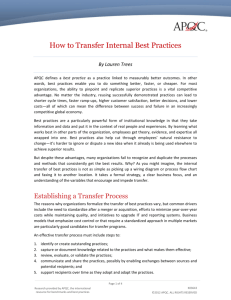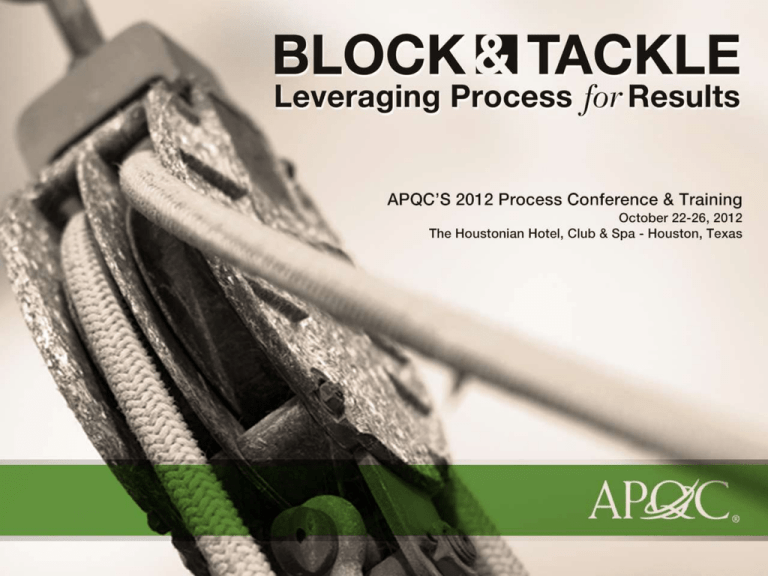
The Power of Financial Mgt.
Process Improvement
APQC’s Process Conference
Workshop Presentation
Mary Driscoll, Senior Research Fellow
October 25, 2012
Today’s Agenda
Trends in FM process improvement (PI)
Ways to assess investments in change
Large investments must align with strategic objectives
and decision-support needs of the business
Cases and best practices
©2012 APQC. ALL RIGHTS RESERVED.
3
Currently pursuing a major
process improvement in FM?
19%
Yes
No
81%
Source: APQC Research, March 2012:
Finance Improvement Programs Now Aim at Both Value and Cost
©2012 APQC. ALL RIGHTS RESERVED.
4
Top Priority?
1%
Both efficiency and effectiveness
11%
Efficiency (improve finance
cost/productivity profile, accelerate
cycle speed, reduce error rates)
16%
Effectiveness (deliver more
effective analytical support to the
business)
Don’t know
72%
Source: APQC Research, March 2012:
Finance Improvement Programs Now Aim at Both Value and Cost
©2012 APQC. ALL RIGHTS RESERVED.
5
Strategic imperatives behind FM
process improvement
Increase speed of core processes to save
money
Reduce risk of accounting/reporting errors
Better and faster planning and forecasting
increase agility
Insightful decision-support sharpens
competitiveness
Evolve service delivery models; e.g. shared
services
©2012 APQC. ALL RIGHTS RESERVED.
6
3 Goals of FM Process Improvement
1.
Classic efficiency gains:
Can you do more with less?
Can you go faster?
Can you avoid error?
2.
Business partner effectiveness:
3.
Guidance on pricing, ABC, M&A, etc.
Create value for shareholders
©2012 APQC. ALL RIGHTS RESERVED.
7
Classic Efficiency Gains:
Finance Gets the Direct Benefit
Faster
Better
Cheaper
Do more with less people
©2012 APQC. ALL RIGHTS RESERVED.
8
Total Cost of Finance as a Percentage of Revenue All Participants
2.5%
2.18%
2.0%
1.5%
1.17%
1.0%
0.62%
0.5%
0.0%
Bottom Performers
Median
Top Performers
N = 524
©2012 APQC. ALL RIGHTS RESERVED.
9
Total Cost to Submit Invoice
$50
$45.98
$45
$40
$39.61
$35
$30
$25.12
$25
$20
$15
$10
$7.65
$4.94
$5
$1.17
$Bottom Performer
Median Performer
All Participants
N = 154
©2012 APQC. ALL RIGHTS RESERVED.
Revenue > $5 Billion
N = 19
10
Top Performer
Number of FTEs Processing Invoices
35
30
28.7
25
20
15
11.6
10
4.6
5
0
Bottom Performer
Median Performer
Top Performer
N = 236
©2012 APQC. ALL RIGHTS RESERVED.
11
Number of Invoices Processed per FTE
60,000
56,000
50,000
40,000
30,000
20,000
12,801
10,000
2,556
Bottom Performer
Median Performer
Top Performer
N = 189
©2012 APQC. ALL RIGHTS RESERVED.
12
Cycle Time in Days between Completion of Annual
Consolidated Financial Statements and the
Release of Earnings
45
40.0
40
35
30
25.0
25
20.0
20
15.0
15
13.8
10.0
10
5
0
Bottom Performers
Median
All Participants
N = 164
©2012 APQC. ALL RIGHTS RESERVED.
Revenue > $5 Billion
N = 50
13
Top Performers
Cycle Time in Days to Complete the
Annual Budget Cycle
100
90.0
90.0
90
80
70
60.0
60
47.5
50
40
30.0
30
29.5
20
10
0
Bottom Performers
Median
All Participants
N = 416
©2012 APQC. ALL RIGHTS RESERVED.
14
Durable Goods
N = 16
Top Performers
Total cost to Process Accounts Payable
per $1,000 Revenue
Highly automated
$0.23 (n=33)
Not highly automated
$0.66 (n=131)
Cycle time in hours from receipt of invoice to entering data into
AP/invoicing system:
Highly automated
4.5 hours (n=43)
Not highly automated
12 hours (n=146)
Cycle time in days from receipt of invoice until payment is
approved and transmitted:
Highly automated
8 days (n=40)
©2012 APQC. ALL RIGHTS RESERVED.
Not highly automated
16 days (n=151)
15
Virtuous Capital Cycle at General Mills
Strong ROC delivers:
- Expected return to investors (WACC)
- Excess capital to return to equity
investors (return in excess of WACC)
Equity and
Credit
Investors
Equity and credit investors
provide capital to GMI
Share
Repurchase
Improving ROC
- Earnings
growth
- Efficient use
of capital
Working
Capital
Dividends
CAPEX
Debt Service
M&A
GMI invests in efficient growth
of business (ROC)
©2012 APQC. ALL RIGHTS RESERVED.
16
Business Partnering Effectiveness
Case Study: General Mills Inc.
Process efficiency leads to less working
capital tied up in operations
Operations managers re-invest the savings
More money available for share
repurchase, dividends, debt service
©2012 APQC. ALL RIGHTS RESERVED.
17
Ensuring Effective Capital Mgt.
General Mills’ Monthly Working Capital Check-up:
Working capital metrics versus the plan and last year,
Receivables performance,
Payables performance,
Review of business unit current assets and current
liabilities,
Overview of business performance and impact on
inventories,
Quarterly working capital
implications versus targets, and
Discussion of potential actions to
achieve targets.
©2012 APQC. ALL RIGHTS RESERVED.
18
General Mills Rigorous Tracking of
AR Performance Metrics
4
100%
100%
95%
3
96%
90%
2
92%
85%
1
88%
80%
0
84%
75%
Avg. Days Delinquent
Collection Effectiveness
GMI
50% Quartile
©2012 APQC. ALL RIGHTS RESERVED.
25% Quartile
75% Quartile
19
Percentage Current
General Mills AP Best Practices
Hybrid service delivery model puts the right
people in the right jobs
Leverage IT to drive efficiencies
P-card for indirect spending
Win-win terms and discount options
©2012 APQC. ALL RIGHTS RESERVED.
20
General Mills Annual Working Capital
Benchmarking
©2012 APQC. ALL RIGHTS RESERVED.
21
General Mills – Supply Chain Finance
Third party service provider establishes vendor
payment capabilities that can be leveraged to
improve working capital performance:
Invoice Visibility Platform (web-based)
Early Payment System (vendor can elect to be paid earlier than
std terms at a discount)
Automated Payment Solution (vendor has certainty of timing and
amount of payment)
GMI introducing across vendor base
Positive approach to terms extension
©2012 APQC. ALL RIGHTS RESERVED.
22
General Mills Mgt. Incentive Metrics
Performance ratings and incentive pay are
tied to shareholder value drivers such as:
Net sales growth
Segment operating profit growth
Diluted earnings per share growth
Return on Capital improvement
©2012 APQC. ALL RIGHTS RESERVED.
23
Average Cycle Time in Days to
Generate Error-Free Invoices
7
6.0
6
5
4.5
4
3.0
3
2.0
2
1.0
1.0
1
0
Bottom Performer
All Participants
n=478
©2012 APQC. ALL RIGHTS RESERVED.
Median
Top Performer
Durable Goods
(Industrial Products, Aerospace and Automotive) n=79
24
Percentage of Receipts Received
Electronically
Top Performer
96.83%
Median
68.59%
Bottom Performer
20%
0%
20%
40%
60%
80%
100%
N=239
©2012 APQC. ALL RIGHTS RESERVED.
25
Performance Gap: Best vs. Worst
29 firms
29 firms
85%-99%
29 firms
29 firms
Percentage of invoice line
items matched the first time
36%
©2012 APQC. ALL RIGHTS RESERVED.
26
Total Cost of AP per Number of Invoices
Processed Annually
$6.00
$5.43
$5.00
$4.00
$2.84
$3.00
$2.00
$1.00
$0.00
Bucket 1
Bucket 4
Median Cost
Source: APQC
©2012 APQC. ALL RIGHTS RESERVED.
27
Key Takeaways!
Low-growth requires more precision in
performance and value management
Business needs advanced analyses; e.g.
cost/service model or risk co-relations
CFOs use savings from FM PI to fund the
move up the analytics maturity curve
Various ways to assess value of PI
Best practices in FM transformation
©2012 APQC. ALL RIGHTS RESERVED.
28
Question & Answer
If you think of others, just contact us.
For follow-up:
Mary Driscoll
Senior Research Fellow
APQC
713-685-7255
mdriscoll@apqc.org
©2012 APQC. ALL RIGHTS RESERVED.
30

